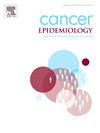1992年至2022年加拿大年龄特异性肺癌发病率趋势
IF 2.4
3区 医学
Q3 ONCOLOGY
引用次数: 0
摘要
历史上男性的肺癌发病率高于女性,但这些发病率正在趋同。在这里,我们详细介绍了1992年至2022年加拿大年龄特异性肺癌发病率的趋势。方法从加拿大统计局获取1992 - 2022年肺癌发病率数据,按性别和年龄分列。我们报告肺癌发病率和年度百分比变化(APC)基于Joinpoint回归。出生队列效应以95 %置信区间(CI)的发生率比(IRR)表示。结果35岁及以上男性肺癌发病率有所下降,其中65岁及以上男性发病率下降幅度最大。55岁以下女性也呈现出类似的下降趋势。然而,55岁或以上的女性在2017年左右发病率开始显著下降之前,发病率保持稳定或上升。出生队列分析显示,1957年以后出生的男性患乳腺癌的风险低于1957年之前出生的男性。女性患病风险在1943-47年达到顶峰,1957年之后,患病风险慢慢回到了20世纪初的水平。结论肺癌发病率的性别差异持续缩小。几十年来,男性的肺癌发病率一直在下降,而女性的下降则是最近才开始的,而且女性在更年轻的时候的发病率首次上升。本文章由计算机程序翻译,如有差异,请以英文原文为准。
Age-specific lung cancer incidence trends in Canada from 1992 to 2022
Background
Lung cancer incidence has historically been higher in males than females, but these rates have been converging. Here we detail the trends in age-specific lung cancer incidence in Canada from 1992 to 2022.
Methods
Lung cancer incidence data from 1992 to 2022 by sex and age were obtained from Statistics Canada. We report lung cancer incidence rates and annual percent changes (APC) based on Joinpoint Regression. Birth cohort effects are presented as incidence rate ratios (IRR) with 95 % confidence intervals (CI).
Results
Lung cancer incidence has decreased among males aged 35 or above with the largest decreases occurring among those 65 or above. Females under 55 showed similar decreasing trends. However, females 55 or above show stable or increasing incidence rates until around 2017 when rates began decreasing significantly. Birth cohort analysis showed males born after 1957 have lower risk compared to those born at of before 1957. Females risk peaked in 1943–47 and the risk after 1957 slowly returned to early twentieth century levels.
Conclusion
The sex difference in lung cancer incidence continues to narrow. Lung cancer rates among males have declined for decades, while the decline among females is more recent and incidence is higher for females at younger ages for the first time.
求助全文
通过发布文献求助,成功后即可免费获取论文全文。
去求助
来源期刊

Cancer Epidemiology
医学-肿瘤学
CiteScore
4.50
自引率
3.80%
发文量
200
审稿时长
39 days
期刊介绍:
Cancer Epidemiology is dedicated to increasing understanding about cancer causes, prevention and control. The scope of the journal embraces all aspects of cancer epidemiology including:
• Descriptive epidemiology
• Studies of risk factors for disease initiation, development and prognosis
• Screening and early detection
• Prevention and control
• Methodological issues
The journal publishes original research articles (full length and short reports), systematic reviews and meta-analyses, editorials, commentaries and letters to the editor commenting on previously published research.
 求助内容:
求助内容: 应助结果提醒方式:
应助结果提醒方式:


